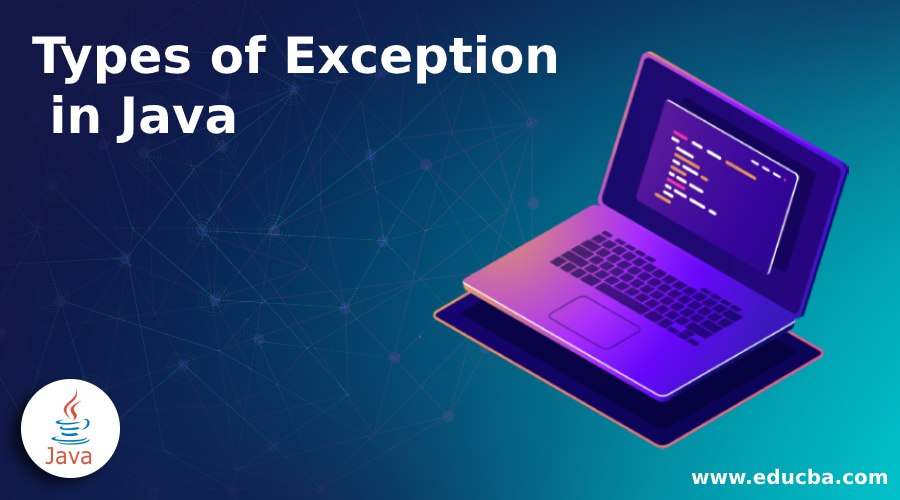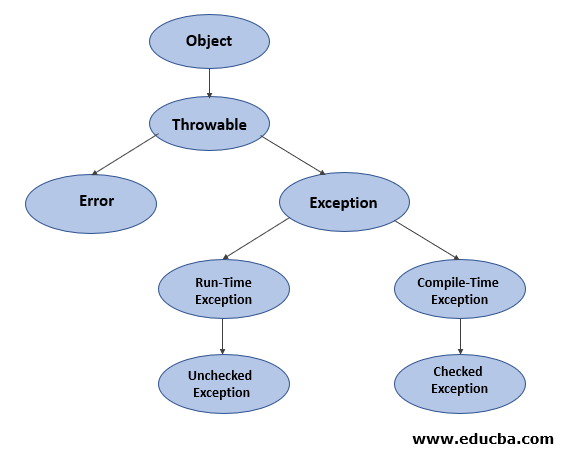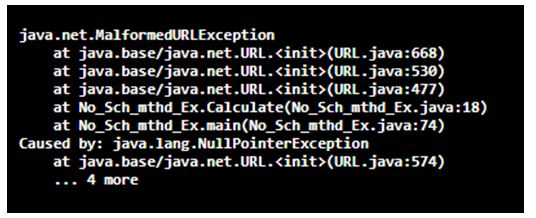Updated April 20, 2023

Introduction to Types of Exception in Java
The following article provides an outline for Types of Exception in Java. Java Exception plays a very pivotal role at the time of execution of program. In general terms, any program with abnormal termination or interruption at the time of execution results into Exception. Java Exception arises at the time of object creation whenever an exception occurs, or any error is caused in runtime and exceptions are related to the objects in java because it is an object-oriented programming language. Thus, there is a hierarchy of the exceptions and errors with throwable, try and catch blocks to trap and identify the exception caused.
Different Types of Exception in Java
The object creation in java program responsible for type of exception follows a hierarchy which is represented as follows:
Exceptions in java while programming is basically bifurcated into two categories such as:
- Build-In Exceptions: These are the types of exception which can be caught using already existing java libraries. It is also known as Unchecked Exception or Runtime Exception.
- User-Defined Exceptions: These are the types of exception which can be caught using some of the customized exception created by the user and the user should have the ability to handle these exceptions. These exceptions can also be called as Checked Exception or Compile time exception.
1. Types of Build-In Exceptions
- Arithmetic Exception
- ClassNotFoundException
- IOException
- ArrayIndexOutOfBoundsException
- FileNotFoundException
- NullPointerException
- NoSuchFieldException
- NoSuchMethodException
- StringIndexOutOfBoundsException
- RuntimeException
- NumberFormatException
- InterruptedException
a. Arithmetic Exception
This Exception gets invoked whenever there is some mismatch at the time of arithmetic computation.
Example:
This program demonstrates the Arithmetic Exception.
Code:
public class Arithmtic_excpn {
public static void main(String[] args) {
{
try {
int first_no = 0;
int scnd_no = 20;
int third_no = 0;
int fourth_no = (first_no-scnd_no)/third_no;
System.out.println ("output after the operation " + fourth_no );
}
catch(ArithmeticException arithmetic_ex) {
System.out.println ("The third number cannot store the value of first number multiplied by second number.");
}
}
}
}Output:
b. ClassNotFoundException
If any class is not defined properly then it will result into ClassNotFoundException.
Example:
This program demonstrates the ClassNotFoundException.
Code:
public class Not_Found_Excp {
private static final String mysql_connector = "com.jdbc.mysql-connector";
public static void main(String[] args) throws Exception {
System.out.println("search for the mysql-connector of jdbc for establishing connection.");
Class.forName(mysql_connector);
}
}Output:
c. IO Exception
When any of the input or output gets terminated abnormally and operation gets failed then it causes IO Exception.
Example:
This program demonstrates the IO Exception.
Code:
import java.io.File;
import java.io.FileInputStream;
import java.io.IOException;
public class IO_Excption_Ex {
public FileInputStream testMethod1(){
File file_a = new File("123.txt");
FileInputStream fileInptstrm = null;
try{
fileInptstrm = new FileInputStream(file_a);
fileInptstrm.read();
}catch (IOException excpn){
excpn.printStackTrace();
}
finally{
try{
if (fileInptstrm != null){
fileInptstrm.close();
}
}catch (IOException excpn){
excpn.printStackTrace();
}
}
return fileInptstrm;
}
public static void main(String[] args){
IO_Excption_Ex inst_1 = new IO_Excption_Ex();
inst_1.testMethod1();
}
}Output:
d. ArrayIndexOutOfBoundsException
Whenever any wrong index is accessed, and the range of the index is unreachable and cannot be accessed then it comes out to be ArrayIndexOutOfBoundsException
Example:
This program demonstrates the ArrayIndexOutOfBoundsException.
Code:
public class Arr_Indx_Out_Of_BOnd {
public static void main(String[] args) {
try{
int ar_0[] = new int[6];
ar_0[8] = 11;
}
catch(ArrayIndexOutOfBoundsException excp){
System.out.println ("Index of the array has crossed the range.");
}
}
}Output:
e. FileNotFoundException
If any file is not properly mentioned in path or does not get opened properly then it will throw FileNotFoundException
Example:
This program demonstrates the FileNotFoundException.
Code:
import java.io.BufferedReader;
import java.io.File;
import java.io.FileReader;
import java.io.IOException;
public class File_Not_Found_Excpt_Exmpl {
private static final String file_nm = "jkl.txt";
public static void main(String[] args) {
BufferedReader rder = null;
try {
rder = new BufferedReader(new FileReader(new File(file_nm)));
String inpt_ln = null;
while ((inpt_ln = rder.readLine()) != null)
System.out.println(inpt_ln);
} catch (IOException excpn) {
System.err.println("catch the IO Exception.");
excpn.printStackTrace();
} finally {
try {
rder.close();
} catch (IOException excpn) {
System.err.println("catch the IO Exception.");
excpn.printStackTrace();
}
}
}
}Output:
f. Null Pointer Exception
This type of exception occurs whenever the members of the object points or refers to any null value.
Example:
This program demonstrates the Null Pointer Exception.
Code:
public class Null_Pointer_Excp {
public static void main(String[] args) {
try {
String art_1 = null;
String art_3= "abc";
System.out.println(art_1.charAt(0));
} catch(NullPointerException excpn) {
System.out.println("This will give a null pointer exception.");
}
}
}Output:
g. NoSuchFieldException
This Exception occurs whenever there is no field present or any variable present.
Example:
This program demonstrates the NoSuchFieldException.
Code:
import java.text.DateFormat.Field;
import java.lang.reflect.*;
public class No_suc_field_excpn_Ex {
public static void main(String[] args) {
No_suc_field_excpn_Ex excp = new No_suc_field_excpn_Ex();
Class any_cls = excp.getClass();
System.out.println("value_of_field=");
try {
java.lang.reflect.Field strng_fld = any_cls.getField("One_strng");
System.out.println("field for the public superclass is found: " + strng_fld.toString());
} catch(NoSuchFieldException excpn) {
System.out.println(excpn.toString());
}
}
public No_suc_field_excpn_Ex() {
}
public No_suc_field_excpn_Ex(String One_strng) {
this.val_OneStrng = One_strng;
}
public String val_OneStrng = "Everything appears to be Exception.";
}Output:
h. NoSuchMethodException
While trying to access any method in a class and that method is not defined clearly or else is missing will lead to NoSuchMethodException.
Example:
This program demonstrates the NoSuchMethodException.
Code:
import java.io.BufferedReader;
import java.io.BufferedWriter;
import java.io.File;
import java.io.FileWriter;
import java.io.IOException;
import java.io.InputStreamReader;
import java.net.MalformedURLException;
import java.net.URL;
import java.net.URLConnection;
public class No_Sch_mthd_Ex {
public static String add_rss;
public static String somefiletext;
public static String initial_page_src;
public static void Calculate() throws MalformedURLException {
URL url_a = new URL(add_rss) ;
URLConnection connect_2 = null;
try {
connect_2 = url_a.openConnection();
} catch (IOException excp) {
excp.printStackTrace();
}
BufferedReader buffrr = null;
try {
buffrr = new BufferedReader(
new InputStreamReader(connect_2.getInputStream()));
} catch (IOException excpn) {
excpn.printStackTrace();
}
String filnm_z = "C:\\Users\\adutta\\Documents\\"+"page_src"+"123.txt";
File file_o = new File(filnm_z);
if (!file_o.exists()) {
try {
file_o.createNewFile();
} catch (IOException excpn) {
excpn.printStackTrace();
}
}
FileWriter flwrtr = null;
try {
flwrtr = new FileWriter(filnm_z);
} catch (IOException exc) {
exc.printStackTrace();
}
BufferedWriter bw = new BufferedWriter(flwrtr);
String textreader;
try {
while ((textreader = buffrr.readLine()) != null) {
bw.write(textreader);
}
} catch (IOException excn) {
excn.printStackTrace();
}
}
public static void set_page_src(String page_src){
page_src = initial_page_src;
}
public static void set_url(String addressname){
addressname = add_rss;
}
public static void set_text_file_name(String celeb_filename_p){
celeb_filename_p = celeb_name_i;
}
public static String celeb_name_i = "type_the_text" ;
public static String url_add_ress = "http//ooo.com";
public static void main(String[] args) {
No_Sch_mthd_Ex.set_page_src(celeb_name_i);
No_Sch_mthd_Ex.set_url(url_add_ress);
try {
No_Sch_mthd_Ex.Calculate();
} catch (IOException excpn) {
excpn.printStackTrace();
}
}
}Output:
i. StringIndexOutOfBoundsException
If the index ranging is negative or more than the defined index range in the string class, then it will result into this exception of StringIndexOutOfBoundsException.
Example:
This program demonstrates the StringIndexOutOfBoundsException.
Code:
public class String_Inx_Out_Of_Bound_Ex {
public static void main(String[] args) {
try {
String ant = "ant crawls very slowly.";
char chrct = ant.charAt(50);
System.out.println(chrct);
}
catch(StringIndexOutOfBoundsException excepn) {
System.out.println("String_Out_Of_Bound_Exception occured.");
}
}
}Output:
j. RuntimeException
During runtime if any kind of exception arise then these types of exceptions are known as RuntimeException.
Example:
This program demonstrates the RuntimeException.
Code:
public class Runtime_Excp_Ex {
public void Demo_Runtime_Exception () {
throw new Running_Exception();
}
public static void main(String[] args) {
try {
new Running_Exception().Demo_Runtime_Exception();
} catch(Exception excpn) {
System.out.println(excpn.getClass().getName());
}
}
}
class Running_Exception extends RuntimeException {
public Running_Exception() {
super();
}
public void Demo_Runtime_Exception() {
throw new Running_Exception();
}
}Output:
k. NumberFormatException
Any exception which cannot get converted into numeric format from the string defined then it will lead to NumberFormatException.
Example:
This program demonstrates the NumberFormatException.
Code:
public class No_Format_Ex {
public static void main(String[] args) {
try {
int value1 = Integer.parseInt ("parasite1") ;
System.out.println(value1);
} catch(NumberFormatException excepn) {
System.out.println("This gives Number Format Exception");
}
}
}Output:
l. InterruptedException
If a thread gets disturbed at the time of waiting, sleeping or while performing some processing then it leads to interrupted Exception.
Example:
This program demonstrates the InterruptedException.
Code:
class ChildThread extends Thread {
public void run() {
try {
Thread.sleep(500);
} catch (InterruptedException excpn) {
System.err.println("Interuppted_Exception occured.");
excpn.printStackTrace();
}
}
}
public class Interuupted_Excpt_Exmple {
public static void main(String[] args) throws InterruptedException {
ChildThread chldth1 = new ChildThread();
chldth1.start();
chldth1.interrupt();
}
}Output:
2. User-Defined Exception
This exception occurs whenever there is some customizable or errors done by user while implementation and execution of program.
Example:
This program demonstrates the user-Defined Exception.
Code:
public class My_Excpn extends Exception {
private static int roll_no[] = {10, 15, 23, 30};
private static String student_Nm[] = {"ani", "viky", "nidhi", "ash"};
private static double marks[] = {20.5, 44.6, 30, 17};
My_Excpn() { }
My_Excpn(String str)
{
super(str);
}
public static void main(String[] args) {
try {
System.out.println("roll_no" + "\t" + "student_Nm" +
"\t" + "marks");
for (int i = 0; i < 4 ; i++)
{
System.out.println(roll_no[i] + "\t" + student_Nm[i] +
"\t" + marks[i]);
if (marks[i] < 60)
{
My_Excpn mrk1 =
new My_Excpn("Student will fail if marks is less than 60");
throw mrk1;
}
}
}
catch (My_Excpn excpn) {
excpn.printStackTrace();
}
}
}Output:
Conclusion
Exceptions in java plays a very pivotal role because it helps in catching and simultaneously throwing of the root cause for an abnormal termination of the program. It often causes and consumes a lot of time for programmers to run and execute programs therefore these kinds of fatal exceptions should not occur frequently at the time of production or even implementation.
Recommended Articles
This is a guide to Types of Exception in Java. Here we discuss the different types of exception in java respectively. You may also have a look at the following articles to learn more –















